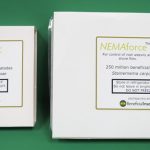General Description
NEMAforce™ SC (Steinernema carpocapsae) are naturally occurring insect-parasitic nematodes that are released in their infective juvenile stage to search out and enter insect pests. Once inside, the nematodes release symbiotic bacteria that quickly kill targeted insects. Reproduction inside the insect releases new generations of infective juvenile nematodes that disperse in search of further prey.
NEMAforce™ SC is active against larval stages of shore flies, as well as other common ornamental and turf pests. NEMAforce™ SC quickly controls pest larvae at the time of application and is persistent in the soil, providing prolonged protection against pest reinfestation. With no restricted entry interval (REI = 0) and no adverse effects on beneficial insects and soil microorganisms, NEMAforce™ SC is ideally suited for use in integrated pest management programs as an important tool for resistance management, worker safety, and environmental responsibility.
Shore Fly Biology and Life Cycle
Shore flies (Scatella stagnalis) are small flies (1/8 inch long) that commonly are found in greenhouses, often near water and green algae. Shore flies occasionally can be confused with sciarid flies, but shore flies are more stoutly built, are stronger fliers and have shorter, un-beaded antennae. Shore fly adults have black bodies, reddish eyes and dark wings with five or more light-colored spots on each wing.
The life-cycle of shore flies consists of an egg, three larval instars, a pupa and an adult.
Females lay 300-500 eggs in areas where algae accumulate, such as growing medium, benches and floors. Eggs hatch into yellowish-brown larvae with two forked, dark-tipped breathing tubes. Larvae are found on surfaces or just under the top layer of growing medium. Development from an egg to an adult requires approximately 4 weeks depending on temperature. Shore flies have multiple generations per year.
Shore Fly Damage
Adults and larvae feed on microscopic algae, dinoflagellates, bacteria, cyanobacteria, and other unicellular organisms. Shore flies are considered a nuisance pest because they leave frass deposits or fly specks on plant leaves, but also can vector several soil-borne diseases including black root rot. Larvae acquire disease by ingesting fungal spores when they feed, which are retained through pupation. When the adult excrete onto plant leaves or the growing medium, it may contain viable fungal spores. In rare cases, frass can build up and cause growth retardation in young cuttings. Flies present in vast numbers also can become an irritation for nursery workers.
Application Details
NEMAforce™ SC can be used preventatively or curatively depending on growing conditions. In either case, treat the soil or growing media and any surfaces containing algae at a rate of 250 million nematodes per 5,400 to 2,750 ft². Start the program using the high rate (250 million/2,750 ft²) on a weekly basis until the population declines to an acceptable level. Application rate can then be reduced, but monitor the population and increase the rate if the population increases. Apply NEMAforce™ SC in a water volume of 10-20 gallons/1000 ft² to target areas where algae is present. These areas may include soil or growing media surfaces, benches, floors, mats, drains, walls or other structural objects. To help eliminate algae, avoid overwatering and over fertilizing plants, remove weeds, old plant material and old growing medium.
Applications should be made in the early morning or late evening to avoid direct sunlight and nematode desiccation. Use blackout curtains, close vents, and switch off artificial lighting during and for at least 2 hours after application so as to minimize both UV light and heat exposure to the nematodes. Spray adjuvants will promote improved application uniformity and allow nematodes to reach the pest more effectively. Remove all sprayer filters of 50 mesh or finer and maintain pump pressure below 300 psi to avoid damaging nematodes. Soil or growing media temperatures should be between 57-86°F (14-30°C).
Monitoring: Apply new yellow sticky cards every 1,000 ft² for the first application and every week after to monitor the decline in the shore fly population. Results may not be realized immediately because NEMAforce™ SC will not control the adults or egg stages.
Purchase
-

NEMAforce™ SC – (50/250 million)
$86.95 – $135.95 Select options This product has multiple variants. The options may be chosen on the product page
